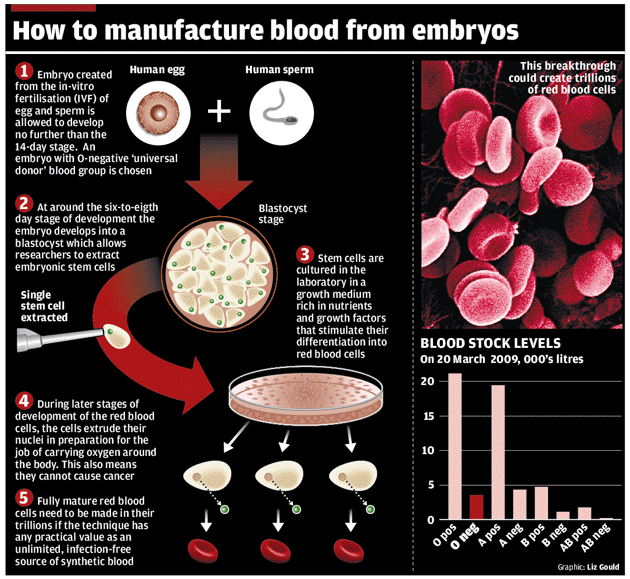Steve Connor: A scientific dream for more than half a century

The ability to make unlimited quantities of red blood cells – which carry vital oxygen around the body – has been a dream of medical researchers for almost half a century. Now that dream is near to reality with developments in embryonic stem cell research.
Scientists have shown that it is possible to take a single stem cell from an early human embryo left over from IVF treatment and stimulate it with nutrients and other chemicals to develop and "differentiate" into mature red blood cells.
Last year, researchers at Advanced Cell Technology (ACT) said they had refined the technique to produce billions of red blood cells from embryonic stem cells in the test tube. This, they said, was a breakthrough in the ultimate goal of producing industrial-scale quantities of synthetic blood.
Stem cells multiply indefinitely and this means that the supply of red blood calls is theoretically unlimited. The cells can be made from universal donor embryos – the O-negative blood type – and can be guaranteed to be free of infections because they have never been inside a human.
But one of the biggest problems is scaling up the procedure to produce industrial amounts of blood. The ACT scientists demonstrated that it is possible to make up to 100 billion red blood cells, an unprecedented number, but a litre of donated blood contains about 5 trillion cells – more than 5,000 times the number of synthetic cells made by ACT.
A great advantage of red blood cells as a potential synthetic product is that they have no nucleus, an adaptation that enables the haemoglobin protein at the centre of the cells to carry oxygen. This means that these synthetic red blood cells cannot develop into cancerous cells because they contain no DNA from a nucleus.
Ultimately, scientists hope to be able to produce portable blood factories that can be transported to disaster zones and battlefields. The US Department of Defence has made it clear that it would welcome a blood-producing unit that could be put on the back of a military vehicle. But this is still many years away.
Join our commenting forum
Join thought-provoking conversations, follow other Independent readers and see their replies
Comments